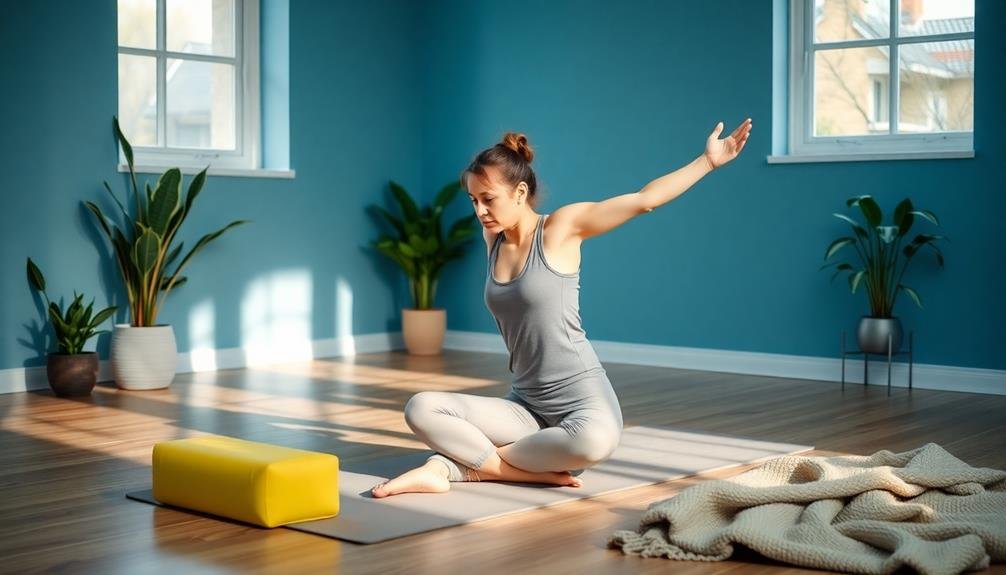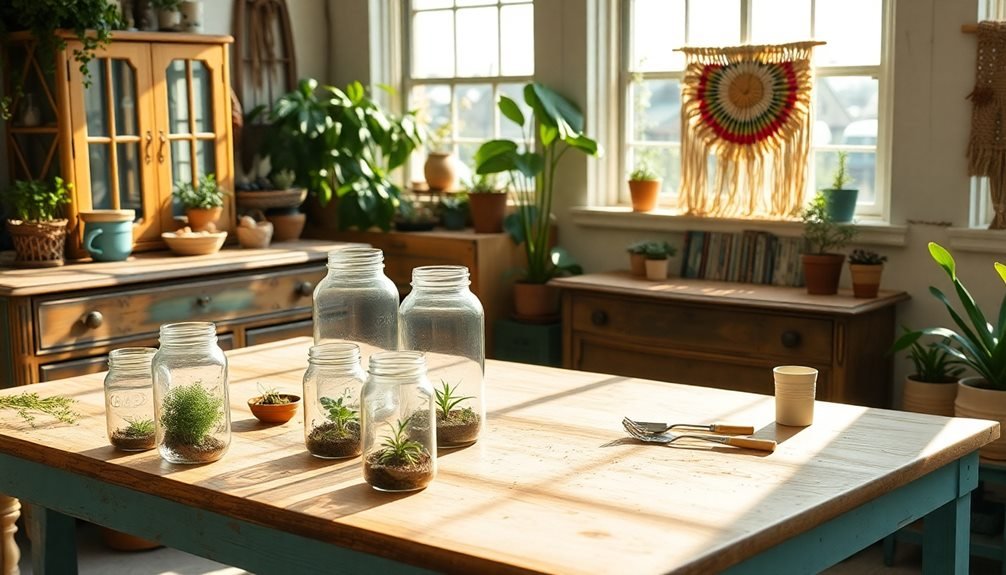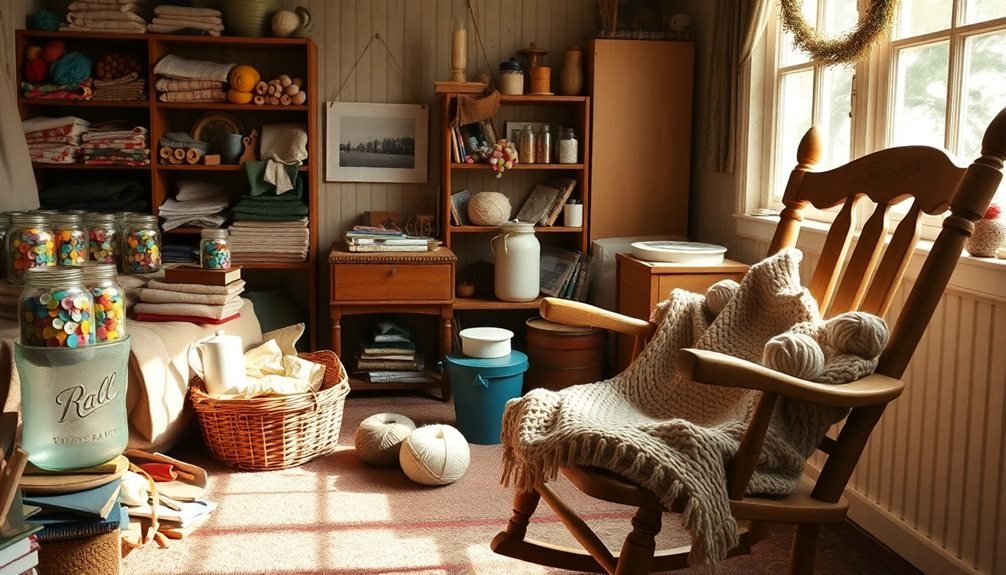Anxious yogis can enhance their practice with supportive props and modifications. You'll find comfort in bolsters for restorative poses, weighted blankets for grounding savasana, and sandbags for added stability. Adjustable straps allow gentle stretching, while wall-supported inversions provide safe exploration. Chair yoga offers accessible alternatives for various poses. Don't forget the power of aromatherapy; essential oils can create a calming atmosphere. These tools help you focus on breath and mindfulness, reducing anxiety during your practice. By incorporating these props and modifications, you'll discover new ways to deepen your yoga experience and find relief from stress.
Key Takeaways
- Bolsters provide physical support and comfort, enabling longer holds for meditation and anxiety relief.
- Weighted blankets offer deep pressure stimulation, calming the nervous system and improving mood.
- Sandbags enhance stability and grounding, promoting focus and reducing physical discomfort in various poses.
- Adjustable straps allow for gradual flexibility improvement and pose modifications, reducing anxiety about limitations.
- Wall-supported poses offer stability for challenging postures, promoting safety and calmness for anxious practitioners.
Supportive Bolsters for Restorative Poses

Three key reasons make bolsters essential props for anxious yogis practicing restorative poses.
First, they provide physical support, allowing you to fully relax into postures without strain. This support helps release tension in your muscles and joints, promoting a deeper sense of calm.
Second, bolsters enable longer hold times in restorative poses, giving you ample opportunity to settle into a meditative state and quiet your mind.
Third, they create a feeling of comfort and security, which is particularly beneficial for those dealing with anxiety.
When choosing a bolster, opt for one that's firm yet comfortable. Rectangular bolsters are versatile and work well for most poses, while round bolsters are ideal for supported backbends.
Look for bolsters with removable, washable covers for easy maintenance.
To use a bolster effectively, place it under your spine for supported fish pose, between your thighs for supported child's pose, or under your knees in savasana.
Experiment with different placements to find what feels most comfortable and supportive for your body.
Weighted Blankets in Savasana

You'll find weighted blankets to be a game-changer for your savasana practice, offering anxiety relief through deep pressure stimulation.
When selecting a blanket, you'll want to choose one that's about 10% of your body weight for ideal comfort and effectiveness.
You can experiment with different folding techniques to concentrate the weight on specific areas of your body, enhancing the calming effect during your final relaxation pose.
Benefits for Anxiety Relief
Weighted blankets offer a soothing embrace during Savasana, providing significant benefits for anxiety relief. When you use a weighted blanket, you'll experience deep pressure stimulation, which can help calm your nervous system and reduce feelings of anxiety. This pressure triggers the release of neurotransmitters like serotonin and dopamine, promoting relaxation and improving your mood.
You'll likely notice a decrease in physical symptoms of anxiety, such as rapid heartbeat and shallow breathing. The blanket's weight can help ground you, making it easier to stay present and focused during your practice. This increased body awareness can enhance your overall yoga experience and deepen your connection to the present moment.
Using a weighted blanket in Savasana can also improve your sleep quality. The comforting pressure may help you fall asleep faster and experience more restful sleep, which is essential for managing anxiety.
You'll find that the blanket's cocoon-like effect creates a sense of security, allowing you to fully relax and let go of tension. This enhanced relaxation can carry over into your daily life, helping you better cope with stress and anxiety outside of your yoga practice.
Choosing Appropriate Weight
When selecting a weighted blanket for Savasana, it's crucial to choose the right weight for your body. Generally, you'll want a blanket that's about 10% of your body weight. For example, if you weigh 150 pounds, a 15-pound blanket would be appropriate.
However, if you're new to weighted blankets, you might want to start with a slightly lighter option and work your way up.
Consider the following factors when choosing your weighted blanket:
- Your comfort level: Some people prefer a heavier weight for more pressure, while others find it too restrictive.
- Your body size: Taller or larger individuals may need a bigger blanket to cover their entire body evenly.
- Your anxiety symptoms: If you experience severe anxiety, a slightly heavier blanket might provide more relief.
Folding Techniques for Comfort
Several folding techniques can enhance your comfort when using a weighted blanket during Savasana.
The most common method is the simple fold, where you'll drape the blanket over your body from chest to feet. This provides even pressure distribution and is easy to adjust.
For those who prefer more weight on their legs, try the triangular fold. Fold the blanket in half diagonally, then place it over your lower body with the pointed end at your feet. This concentrates the weight on your legs and hips, promoting deeper relaxation.
If you're sensitive to pressure on your chest, opt for the U-shape fold. Fold the blanket in half lengthwise, then wrap it around your body, leaving your chest uncovered. This technique offers grounding support while keeping your breathing unrestricted.
For focused calming, try the burrito roll. Lie on one edge of the blanket and roll yourself up, leaving your head exposed. This cocoon-like wrap provides a sense of security and can be particularly soothing for anxiety.
Experiment with these folding techniques to find what works best for you, adjusting as needed for maximum comfort and relaxation during your practice.
Grounding Sandbags for Stability

You'll find grounding sandbags incredibly useful for enhancing your stability during yoga practice.
These versatile props help distribute weight evenly, providing balance and anchoring restless limbs when you need it most.
You'll also appreciate the added comfort they offer in seated poses, allowing you to focus on your breath and mindfulness rather than physical discomfort.
Weight Distribution and Balance
Many anxious yogis struggle with balance and stability during their practice. Grounding sandbags can be incredibly helpful in addressing these challenges by providing additional weight and promoting better weight distribution.
When you're feeling unsteady, placing a sandbag on specific areas of your body can help you feel more secure and connected to the ground.
To effectively use sandbags for weight distribution and balance:
- Place a sandbag across your thighs in seated poses to anchor your lower body.
- Rest a sandbag on your lower back during child's pose to deepen the stretch and create a sense of security.
- Position a sandbag on your feet during savasana to promote grounding and relaxation.
Anchoring Restless Limbs
For anxious yogis, restless limbs can be a significant barrier to achieving a calm and focused practice. Grounding sandbags offer a simple yet effective solution to this common challenge. These weighted props provide gentle pressure that can help anchor your body and calm your nervous system.
Place sandbags on your thighs or lower legs during seated poses to create a sense of stability and groundedness. In reclined positions, drape them across your hips or feet to promote relaxation and release tension. You'll find that the added weight encourages your muscles to soften and your mind to settle.
When using sandbags, start with lighter weights and gradually increase as you become more comfortable. Position them carefully to avoid discomfort or restricted blood flow.
For maximum benefit, combine sandbag use with deep, mindful breathing.
Don't hesitate to experiment with different placements to find what works best for you. Remember, the goal is to create a sense of security and stability that allows you to fully engage in your practice.
With consistent use, you may find that grounding sandbags become an invaluable tool in managing anxiety and enhancing your yoga experience.
Comfort in Seated Poses
Building on the stability provided by grounding sandbags, seated poses can become a source of comfort rather than anxiety. When you're feeling restless or uneasy in seated postures, these weighted props can offer a sense of security and groundedness.
Place a sandbag on your thighs or across your lap to create a gentle, reassuring pressure that helps calm your nervous system and anchors you to the present moment.
For maximum comfort in seated poses, consider these additional modifications:
- Use a folded blanket or cushion beneath your sit bones to elevate your hips and reduce strain on your lower back.
- Place blocks under your knees if they don't comfortably reach the floor, promoting proper alignment and reducing tension in your legs.
- Support your back against a wall or bolster to maintain an upright posture without expending excessive energy.
Adjustable Straps for Gentle Stretching

Adjustable straps are indispensable tools for anxious yogis seeking gentle stretching options. They allow you to modify poses and gradually increase flexibility without pushing your body beyond its limits. These versatile props can help you maintain proper alignment and reduce the risk of injury, which is particularly important if you're feeling anxious or tense.
When using adjustable straps, start with a looser setting and gradually tighten as you become more comfortable. For hamstring stretches, loop the strap around your foot while lying on your back, gently pulling your leg towards you. This modification lets you control the intensity of the stretch without straining.
In seated forward folds, wrap the strap around your feet to create a gentle pull, helping you maintain a straight spine without overreaching.
Adjustable straps are also excellent for shoulder openers. Place the strap behind your back, holding one end in each hand, and slowly move your arms apart to stretch your chest and shoulders.
Remember to breathe deeply and listen to your body, adjusting the strap as needed. With practice, you'll find that these props can greatly enhance your yoga experience, allowing for a more relaxed and mindful practice.
Wall-Supported Inversions and Backbends

Many anxious yogis find wall-supported inversions and backbends to be incredibly grounding and calming practices. These poses offer a sense of stability and safety, allowing you to explore challenging postures without fear of falling. By using the wall as a prop, you'll experience the benefits of inversions and backbends while maintaining control over your body's position.
When practicing wall-supported inversions like legs-up-the-wall or handstand prep, you'll feel a gentle reversal of blood flow, which can help calm your nervous system. For backbends, the wall provides a stable surface to lean against, allowing you to gradually open your chest and spine without overexertion.
To make the most of wall-supported practices, try these modifications:
- Place a folded blanket under your lower back for extra cushioning in supported bridge pose.
- Use a yoga block between your thighs in wall-supported handstand to engage your core.
- Slide a bolster along your spine in reclined bound angle pose against the wall for a gentle heart opener.
Remember to listen to your body and breathe deeply throughout these practices. With consistent use, you'll likely find that wall-supported inversions and backbends become powerful tools for managing anxiety and promoting relaxation.
Chair Yoga Modifications

Chair yoga modifications offer another excellent option for anxious yogis seeking accessible and supportive practices. You'll find that using a chair can provide stability and comfort, allowing you to focus on your breath and movement without worrying about balance or strain.
Start by sitting on the edge of your chair with your feet flat on the floor. You can perform seated twists, forward folds, and gentle backbends while using the chair for support. For standing poses, place your hands on the chair's back to steady yourself during warrior poses or lunges. This modification helps you maintain proper alignment and reduces the risk of falling.
You can also use the chair for restorative poses. Try reclining over the seat for a supported fish pose or rest your legs on the seat for a modified legs-up-the-wall pose. These variations promote relaxation and stress relief.
Don't hesitate to incorporate props like blocks or straps alongside your chair. They'll enhance your practice by providing additional support and allowing for deeper stretches.
Essential Oils for Calming Practice

Aromatherapy can enhance your yoga practice by creating a calming atmosphere and promoting relaxation. Essential oils are a powerful tool for anxious yogis, offering natural support for stress relief and mental clarity.
When selecting oils for your practice, consider lavender for its soothing properties, frankincense for grounding, and bergamot for uplifting your mood.
To incorporate essential oils into your yoga routine:
- Add a few drops to a diffuser before starting your practice.
- Apply diluted oil to your wrists or temples for a personal aromatherapy experience.
- Spritz a yoga mat spray infused with calming oils onto your mat.
Remember to choose high-quality, pure essential oils and always dilute them properly before applying to your skin. Start with a small amount and observe how your body responds.
Some popular blends for anxiety include lavender and chamomile, or ylang-ylang and bergamot. You can also create a rollerball blend to carry with you for quick stress relief throughout the day.
Frequently Asked Questions
How Can I Overcome Anxiety About Attending a Public Yoga Class?
You can overcome anxiety about attending a public yoga class by starting small. Try online classes first, then visit a studio during off-peak hours. Bring a friend for support and remember that everyone's focused on their own practice.
Are There Specific Breathing Techniques to Reduce Anxiety During Practice?
You can try several breathing techniques to reduce anxiety during practice. Focus on deep belly breathing, alternate nostril breathing, or the 4-7-8 technique. These methods help calm your nervous system and center your mind during yoga.
What Should I Do if I Experience a Panic Attack Mid-Session?
If you experience a panic attack mid-session, pause your practice. Focus on slow, deep breaths. Gently remind yourself you're safe. If needed, leave the room quietly. Don't push yourself; it's okay to take breaks.
Can Certain Yoga Poses Trigger Anxiety, and How Do I Avoid Them?
Yes, certain poses can trigger anxiety. You should listen to your body and avoid poses that make you uncomfortable. Try modified versions, use props for support, and focus on breath work to stay grounded during your practice.
How Often Should Anxious Beginners Practice Yoga for Optimal Mental Health Benefits?
You should aim to practice yoga 2-3 times a week as an anxious beginner. Start with shorter sessions of 15-20 minutes and gradually increase. Consistency is key, so find a routine that fits your schedule and stick to it.
In Summary
You've now got a toolkit of props and modifications to make your yoga practice more accessible and anxiety-friendly. Remember, it's okay to adapt poses to suit your needs. Don't hesitate to use these tools to create a safe, comfortable space for yourself. With time and patience, you'll find what works best for you. Keep exploring, stay gentle with yourself, and embrace the journey. Your practice is uniquely yours – honor that.





Leave a Reply